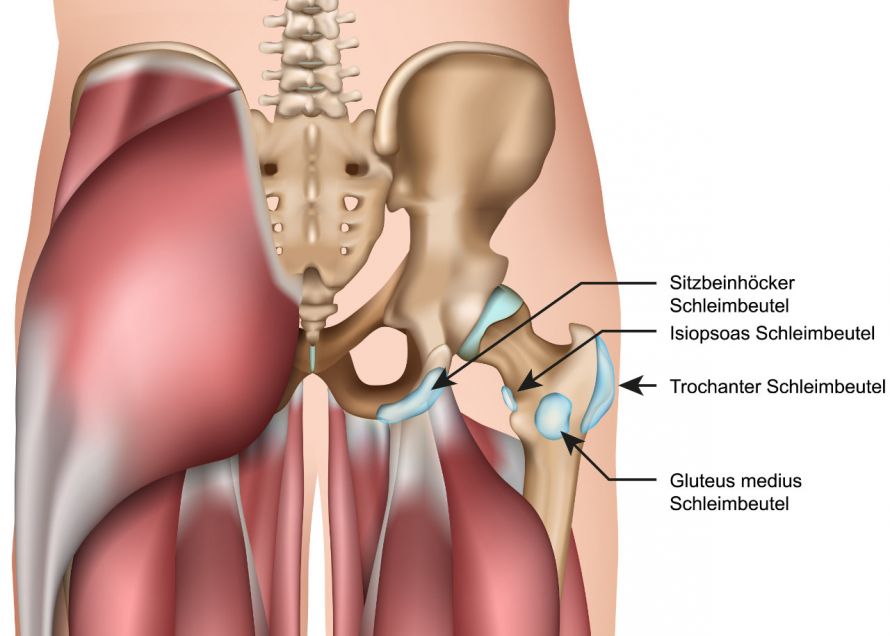As in all joints, there are also bursae in the hip, which take on a complex task. Let's think of bursae as small flat cushions of tissue that contain a gel-like fluid. They form a kind of springy buffer that reduces the friction of ligaments or muscles against bones and absorbs the pressure on them.
There are several of these small shock absorbers at the hip:
- At the ischial tuberosity,
- At the hip joint capsule, and
- On the inner and outer side of the femur near the hip (greater trochanter).
If the bursae become inflamed, more tissue fluid accumulates inside them, which makes the bursa swell. This swelling now presses on the surrounding tissue, resulting in pain, usually associated with restricted movement.

The anatomy of the hip and the location of the bursa © bilderzwerg | AdobeStock
Trochanteric bursitis is often caused by mechanical overloading. Among those particularly susceptible are athletes and people who are unaccustomed to a lot of
- Running,
- Walking,
- Cycling, or
- Trying new sports.
Incorrect stresses and misalignments also contribute to the development of bursitis.
Sometimes viruses or bacteria are also responsible for hip bursitis. The pathogens enter the bursa from the bloodstream through the encapsulated membrane, where they then trigger an infection. In this case, physicians refer to it as septic bursitis.
In older people, hip bursitis is often associated with rheumatic diseases or gout.
The pain experienced depends on the location of the affected bursa. Diffuse or localized pain on the outside of the hip or, less commonly, in the groin is possible.
The hip pain associated with trochanteric bursitis is not related to movement. That is, it often occurs even at rest. However, the discomfort increases significantly with weight bearing and leg movement. If the bursa in the outer hip area is inflamed, the hip hurts even when the patient is lying on their side.
Unlike other types of bursitis, there are no visible signs typical of inflammation. The area of inflammation is buried too deeply under the muscles and tissues for swelling, warming, and redness.
However, the affected area hurts when pressure is applied to it.
In terms of self-administered treatment,
- Cooling gels and ointments and
- Applied cooling pads
have proven effective in providing pain relief. In the acute stage, it is helpful to immobilize the joint for a few days to counteract the inflammation. Limit your movements to what is necessary during this resting phase. Flex the hip as little as possible and avoid unnecessary walking.
To support the healing process, applying special "Y" strip kinesiology tape is also an adjunctive measure. These tapes relieve the joint.
If there is no improvement after a few days despite resting the joint, it is better to consult a doctor.
A doctor for orthopedics is the right point of contact for hip pain. Diagnosis often proves difficult. The symptoms of hip bursitis are similar to those of hip osteoarthritis or other signs of wear and tear. Often diffuse pain in the hip area does not clearly indicate bursitis at first.
Bursitis is often caused by overloading the hip joint. Therefore, the doctor will first ask you about any changes in habits or activities.
They will then check whether pain caused by pressure can be triggered at the corresponding location. The physician will use a blood test to determine the levels of inflammation. This helps distinguish bursitis caused by overexertion or by pathogens.
The physician may also consult imaging techniques, such as
to make a definitive diagnosis.
Medical therapy is primarily based on which type of trochanteric bursitis is present. Septic bursitis (caused by pathogens) is treated differently than exertion-related bursitis.
However, other parameters are also included in the treatment. For example, the stage must be distinguished:
- Hip bursitis in the early stages,
- Acute bursitis, or
- Chronic hip bursitis.
The patient's age and other possible underlying conditions that could influence therapy such as
- Rheumatism,
- Osteoarthritis, or
- Gout,
play a role here.
If the patient has septic bursitis, they will receive antibiotics or viral drugs depending on the responsible pathogen. Surgical treatment is often necessary for such forms.
In the case of bursitis caused by overexertion, the doctor first prescribes
- Immobilization of the hip and
- Anti-inflammatory and analgesic drugs.
Their task is to reduce the inflammatory process in the long term. After resting, the doctor will recommend special exercises that will slowly and gently mobilize the hip again.
The duration of the healing process also depends on the factors mentioned above. The healing process is fastest for bursitis caused by mechanical stress. A significant improvement can be expected within one week.
In chronic courses, treatment sometimes takes several weeks.
In rare cases, treatment with anti-inflammatory drugs is unsuccessful, leaving surgery as the only option. In this procedure, the surgeon removes parts of the inflamed bursa. This can stop the inflammatory process and prevent a permanent restriction of movement.




















